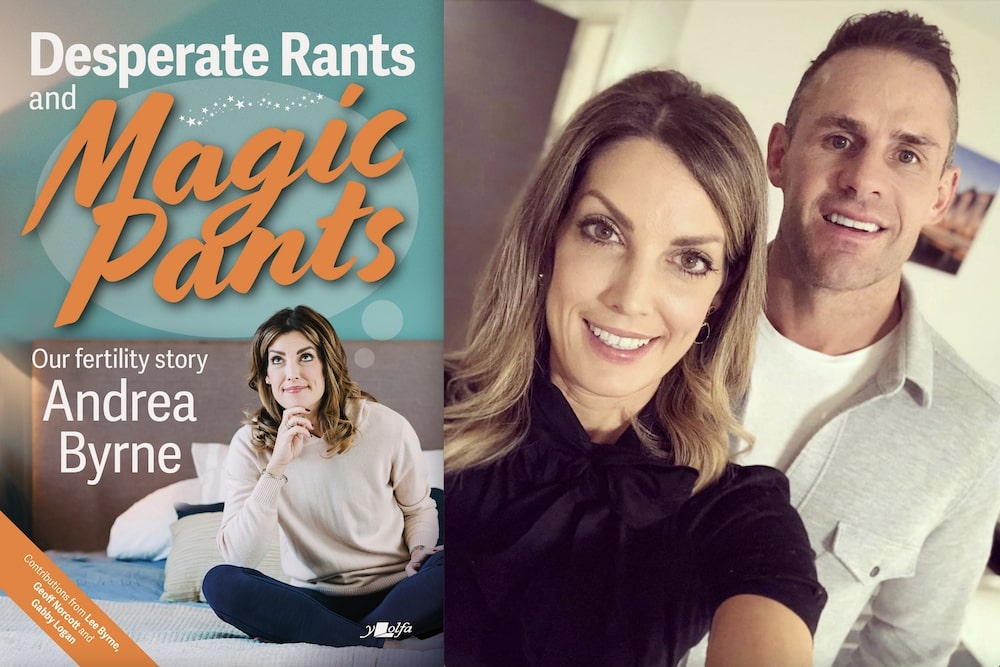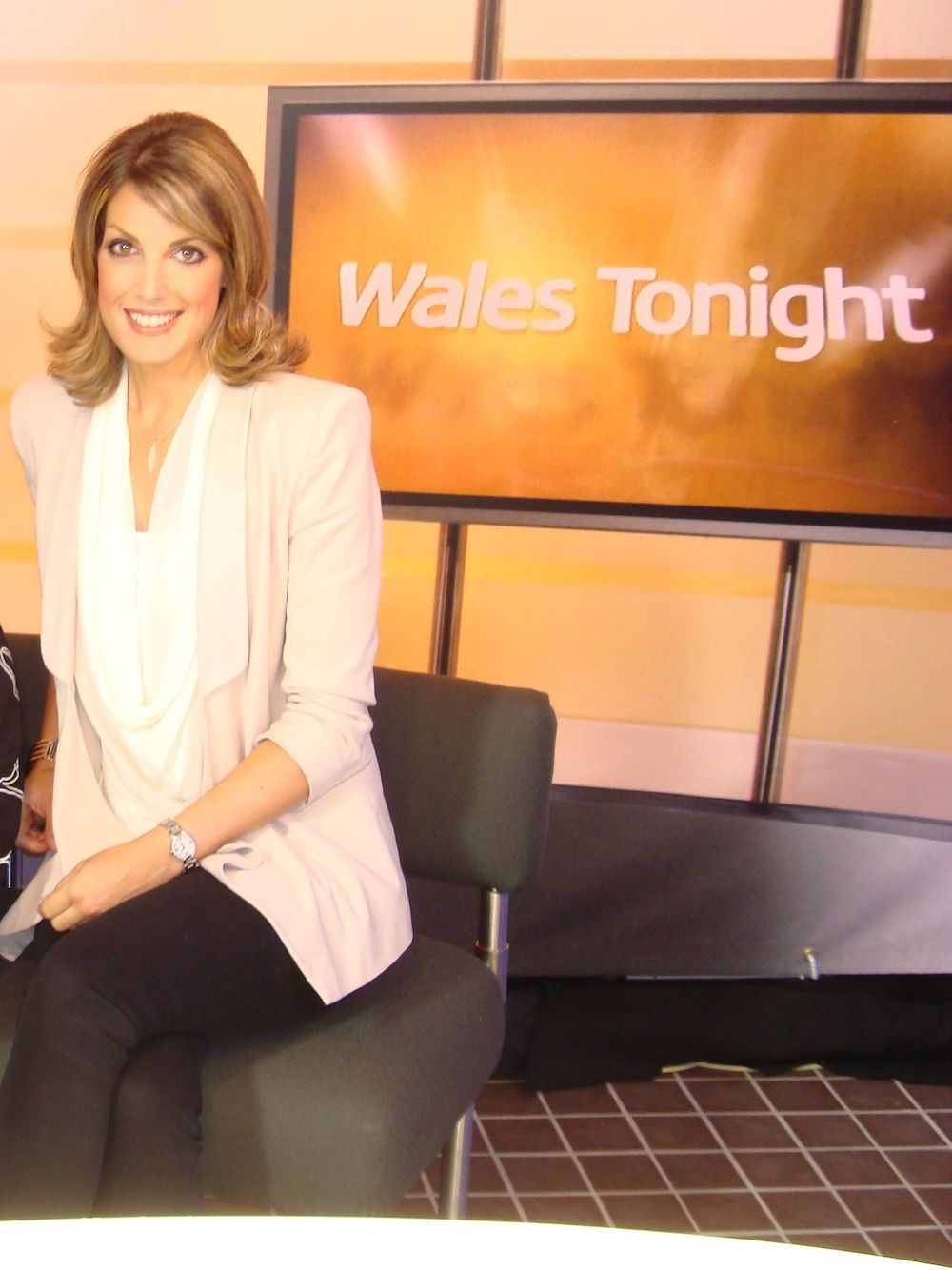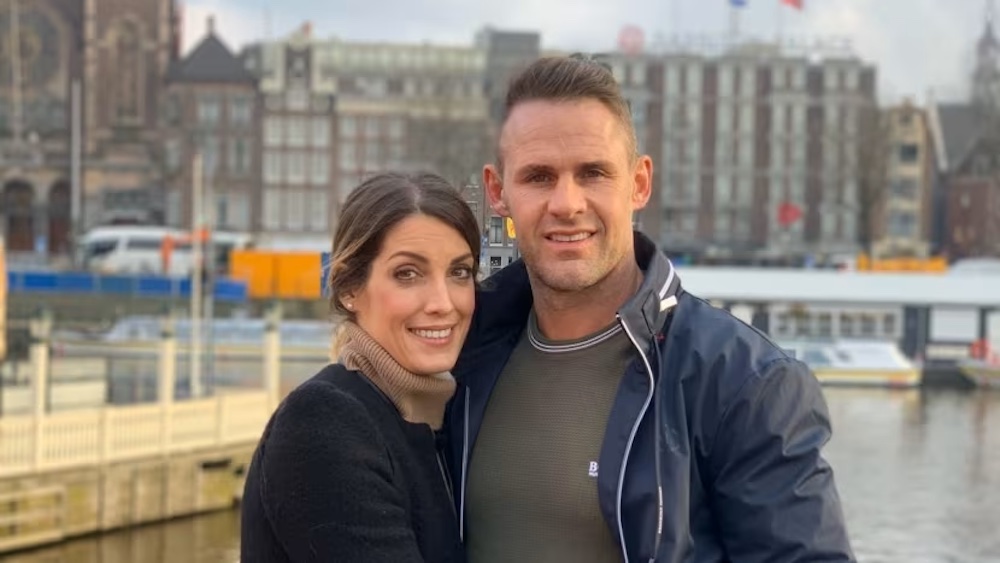Andrea Byrne maps her emotional infertility journey in new book

Andrea Byrne is a familiar face on ITV News in Wales. As well as anchoring Wales at Six, she has presented the UK-wide ITV News at Ten, Evening News, Lunchtime News, GMTV and current affairs programmes Tonight and Wales This Week.
Her personal life is less well-known. After a whirlwind romance and dream wedding to Wales and British and Irish Lions rugby star Lee Byrne, the fairytale fizzled when it came to trying for a baby.
Seven gruelling years of invasive medical procedures and alternative therapies, none of which worked, left the couple almost completely without hope.
Now Andrea has written a book ‘Andrea Byrne: Desperate Rants and Magic Pants’ to try to encourage others to open up and talk about infertility, which NHS figures show affects 1 in 7 couples today.
“During the Coronavirus pandemic, the idea emerged of creating and hosting a podcast,” says Andrea. “There weren’t a lot of conversations about fertility going on in any form of media, and as this is something very close to my heart, I took a deep breath and created Making Babies: A Fertility Podcast.
“With the aim of raising awareness and helping others, we discussed so much of the stuff I’d have wanted to hear if it had been me just starting out on this muddle of a journey – not just about IVF but also about miscarriage, sperm donors, surrogacy, male infertility and holistic alternatives which might support medical treatments. The number of messages I received and the positive feedback from people I had never met was truly humbling. It felt as if Making Babies was really making a difference.
“The podcast was a big step: up until then, Lee and I had been quite private about the fact that we had ended up lost in the infertility vortex for so many years, and creating a platform for other people to talk inevitably meant more sharing on our part too.
“But gradually I knew I wanted to say more. The response to the podcast proved that there was an audience which needed these stories to help with their own.
Unboxing of… Desperate Rants and Magic Pants by @AndreaByrneTV 🤩
“Andrea Byrne eloquently, emotionally and bravely relates her and her husband Lee’s fertility story. This is a book which will be a source of strength and company for anyone grappling with infertility.” pic.twitter.com/RJ9NeEm6rb
— Y Lolfa (@YLolfa) October 2, 2024
“The idea of writing a book about our fertility journey became ‘Desperate Rants and Magic Pants’. Some of the guests on Making Babies have been generous enough to let me feature their stories in it too, including comedian Geoff Norcott, Channel 5 weather’s Clare Nasir and BBC sports presenter Gabby Logan. This means I’ve been able to represent all sorts of other experiences along the fertility spectrum as well as our own.
“I didn’t write it for sympathy, or to make a quick buck: I wrote it to try to be a source of strength and company for people grappling with infertility, and to help foster better awareness in those who are close to anyone struggling to start a family. It can be difficult to know how to open up the conversation. Well, maybe the book can help.
“It’s certainly helped me to talk frankly at last about what we went through. I hope this will help others have the courage to do the same, because it’s a conversation that desperately needs to be had more often.”
Join @AndreaByrneTV as she signs copies of her new book, Desperate Rants and Magic Pants which has contributions from @leebyrne @GeoffNorcott and @GabbyLogan https://t.co/Kd8QKTawYT pic.twitter.com/kcybaWluQe
— Storyville Books 📕 (@storyvillebook) September 14, 2024
Extract from Desperate Rants and Magic Pants
Beginning of the end
It was Monday 21 May, 2018. This date I know, because it was the beginning of the end.
I’m in the dressing room at the ITV studios in Cardiff, getting ready for tonight’s live news programme at 6pm. In the newsrooms outside of London, we do our own make-up and – although it may sound strange to my fellow presenters – I wouldn’t have it any other way. For me, it provides a few minutes of quiet time alone to gather my thoughts before we go into a routine of rehearsals and pre-recorded promotions and interviews, which run at quite a pace as we hurtle towards ‘on-air’ at 6pm. Whilst most people are heading home, winding down, preparing food and catching up on the evening headlines, for newsrooms, it’s peak time.
In California, it is approaching 9am. In the sunshine state they are just arriving for work. Lee and I have recently been having fertility treatment at a clinic in San Diego. As the clinicians fire up their computers and check in with the laboratory results overnight, they then go on to update their patients, usually via email. The emails come to me, partly due to Lee’s dyslexia, and partly because I am desperate to feel like I am in control of something when actually, of course, by the very nature of infertility, I am in control of nothing.
Six days ago, Linda from the lab team emailed to tell me how many embryos had survived of the ones we had produced during our in vitro fertilisation (IVF) cycle with them. Her email dropped in my inbox whilst we were on air. I saw it during the post-programme debrief, digesting the information whilst attempting to coherently contribute to a debate about the news show’s content from that night. Linda’s note ended by telling us that we would have the next results we were awaiting in 10 days’ time.
The next results, we both know, are crucial. They will determine our future like no other results over the last six years.
Since we married in 2012, we’d had no success trying to conceive and we’d become unfortunate veterans of the fertility game. We’d endured multiple treatments in varying forms, both traditional and experimental. Our journey had taken us to clinics in Cardiff, London and France. The latter saw me taking an unpaid year-long sabbatical to join Lee in a city called Clermont-Ferrand, where he was playing professional rugby for three years.
Our medical motivation for my leave of absence was unknown to most people and I became the envy of my colleagues, who imagined me lucky enough to be able to indulge myself in a 12-month life-enriching continental experience. In reality, I was spending most of my time at hospital appointments being scanned, operated on, pumped full of hormone-altering drugs and navigating the intricacies of French infertility vocab. Although of course I knew we were fortunate for me to be able to take the year away from work at all.

The experience at every clinic which treated us had followed a similar pattern. Perhaps there might be a small change in protocol and an experimental drug would be thrown into the treatment cycle, but the outcome was always the same: failure.
On some occasions, Lee’s sperm did fertilise a good number of my eggs in the lab and we ended up with a decent number of embryos. But there was no pregnancy. On other occasions, we used embryos frozen from a previous cycle, but the treatment often barely got started before being cancelled. Once, from one of these cycles, there may have been a pregnancy. Possibly what’s known as a chemical one, which is really a crude term for it being too early to tell if anything really happened or not. But that, too, came to nothing. On another occasion, there definitely was a pregnancy. But that ended in early miscarriage.
The failure was always put down to one thing, on repeat. It was never, we were told, the quality or quantity of the embryos we were producing, which is so often the issue for couples. According to what could be seen under a microscope, they were OK. For us, it was always the fragility and thinness of my womb lining that was the problem. Fun fertility fact for you: for an embryo to ‘stick’ in the womb and start a pregnancy, a woman’s womb lining should ideally be at least 8 mm thick. Well, mine was often only edging past 3 mm. And so, eventually, each doctor would conclude the same thing. I had what seemed to be an unfixable rare genetic defect. We had to accept I probably couldn’t carry a child.
Heading Stateside
So we had changed course. Quite drastically. To California. In the States, we were doing something vastly different. And to do it, we needed to know whether our embryos really were OK, or if they had hidden chromosomal defects – issues that apparently couldn’t even be seen on first inspection in the lab.
Why? Because with our new plan, it would not be the thickness of my womb lining that mattered.
Why? Because I wouldn’t be the one carrying our baby.
Why? Because the reason we had travelled to America was to find a surrogate mother.
That’s right. Deep breath. Big move. Another woman – a woman we’d not yet met – would be ‘hosting’ our embryo and growing our child. Because I couldn’t.
But hold on. Pause a moment. I think I may have just made the transition from IVF treatment to surrogacy sound like an easy one. But at the time when we were trying to become parents, it was anything but:
1. Commercial surrogacy was (and at time of writing still is) illegal in the UK, although you can pay a friend on an expenses-only basis.
2. But this was only possible if you knew a friend or relative willing to do it. Otherwise, you needed to sign up to a non-profit matching agency.
3. But, at that time there was a shortage of surrogates coming forward through this means, and non-profit agencies which pair ‘intended parents’ (me and Lee) with a surrogate had stopped taking on new clients. Fortunately, this situation has now massively improved, but for us, the other option to consider was going abroad to somewhere with a manageable price tag and reasonably close to home. Somewhere like Eastern Europe.
4. But Eastern Europe, despite being reasonably-priced, lacked a sufficiently developed bureaucratic and legal framework to ensure safe and efficient passage of parents and babies with passports back to the UK post-delivery. America, however, had well-developed and sound legislation in place.
5. But American surrogacy comes at a cost which is insurmountable for most people.
There you go. I think that sums it up pretty well for now. Not an easy move to make.
However, despite having already spent thousands of pounds on treatment, we did register for surrogacy in America. In the end, the decision to pursue a new life in a new way came from another life being taken far too soon. My father passed away suddenly in early 2017. He knew of our desperation to have a family and, to me, it seemed undeniably appropriate that we should use his legacy to enable us to pursue the possibility of creating his grandchild.

So we had written our letters and sent our photographs to a surrogacy agency in the States, hoping that a surrogate mum somewhere on the West Coast would go through the files, like us and pick us. It’s a complex process to get there, though. Surrogacy isn’t widely talked about, so let me give you a snapshot of how it all works.
The in vitro fertilisation (IVF) side of things is largely the same. First, I have injections of hormones during the first half of my menstrual cycle to stimulate my ovaries to produce an unnatural number of eggs that month (usually a woman produces one egg per month in her menstrual cycle).
Controversial procedure
Alongside these injections, I have a series of ultrasound scans on my ovaries to tell the doctors when the optimum time is to operate in order to remove – ‘harvest’ – the eggs. Then the eggs are fertilised with Lee’s sperm, or sometimes one sperm is directly injected into each egg. Some will survive and create embryos which could create babies, others will not. The embryos which are created are left to develop in the lab. Again, some will survive, others will not. A few days later, the surviving embryos – if they look to be good quality – are frozen. At a later date, one or maybe more will be thawed and transferred to the womb of the surrogate mother.
As I’m sitting in the dressing room on 21 May 2018, what we already know from Linda in California is that from our cycle in San Diego we have ended up with three embryos considered suitable for use. Not a bad result. Up until now, the test and results process is all fairly familiar to us from previous cycles. But there’s one more hurdle to overcome with the embryos. And this part is all new.
Following their survival, our three embryos were sent for what’s known as pre-implantation genetic screening (PGS) – which has actually since become a controversial procedure. In America, this was an obligatory part of the surrogacy process at the time, and it seemed to make sense. It’s meant to give everyone the least chance of traumatic failure and the best chance of success. And it’s even more important as a woman gets older and her embryos become more vulnerable to being faulty. The screening looks at the chromosomes of each embryo. A normal embryo will have a normal number of chromosomes. ‘Normal’ means a higher chance of implantation and a lower chance of miscarriage and/or birth defects.
It is these results we are waiting on. If one embryo tests as chromosomally normal, it’s the beginning of our surrogacy journey in earnest. Without a normal embryo from this testing, it’s game over.
I’m not expecting any news that particular day – I thought it was too soon. So I’m hot-brushing my hair; I’m applying my lipliner; I’m tweeting about what we have coming up on the programme; I’m running through my interview topics; and I’m listening to other broadcasters’ headlines on the radio.
I can’t remember why now, but I check my emails. Maybe in those days I still had pop-up notifications on. Or maybe we were awaiting some last-minute confirmation on details of a story. Whatever the reason, four days earlier than expected, a new email from San Diego is sitting in my inbox. I start to panic and sweat. My stomach begins to churn. My heart rate soars. None of these feelings are new. In fact, they have become my normal. I’ve lived with anxiety for a long time now. But today, the stakes are at their highest.
With all things fertility, where you hardly dare to be optimistic for fear of having your hopes crushed, I have in fact been cautiously upbeat about the PGS test results. My reasoning? We’ve taken a huge decision to go down the route of surrogacy. Huge emotionally, huge physically and huge financially. I suppose I feel we deserve a break. I feel we deserve good results in return for letting go of the hopes of my own pregnancy and accepting a different way forward.
I open the email.
NO embryos have tested as ‘normal’. Not one single embryo. Zero. After hoping and planning for months, injecting drugs again for weeks and spending tens of thousands of pounds, the result is failure. Again.
In a matter of seconds, darkness consumes the sliver of light I’ve dared to let in. I am empty and nauseous at the same time. A familiar feeling. I know that even if I don’t spiral into emotional disaster right now, it is only a matter of time. Quickly the ‘what ifs’ I have worked so hard to banish come scurrying out from the nooks and crannies of my mind.
“What if the embryos all fail? What is our future?”
“What if the embryos all fail? Will Lee even want to stay with me?”
“What if the embryos all fail? What’s the point in anything anymore?”
This feels like the end.
I sit, motionless. My painted face is illuminated by a surround of spotlights in the mirror. It’s a metaphor for what life has become. A continuous masking of our painful reality from the world. And then, as on so many other occasions, I look at my tear-streaked reflection in the mirror, patch up the damaged foundation, breathe deeply, walk out of the dressing room, put on a smile and walk through a busy newsroom, and on to the set.
“Good evening. I’m Andrea Byrne. Welcome to the programme.”
Desperate Rants and Magic Pants: Our Fertility Story by Andrea Byrne (Y Lolfa, £12.99) is available now online and from all good bookshops. Her TedX talk Fertility and The Forgotten Sex and her Royal Television Award-winning documentary Miscarriage: The Hidden Loss are also both available to watch online.
Support our Nation today
For the price of a cup of coffee a month you can help us create an independent, not-for-profit, national news service for the people of Wales, by the people of Wales.




